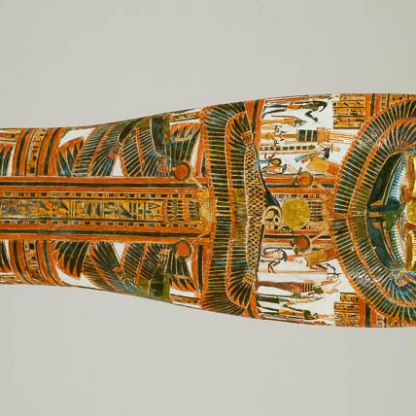Relief of the Heretic King Akhenaten

'Your works are so numerous, though hidden from sight, Unique god – there is none beside him. You mould the earth to your wish, you and you alone ...'
From The Great Hymn to the Aten.
The king depicted twice on this limestone relief is Amenhotep IV, who early in his reign changed his name to Akhenaten, meaning ‘servant of the Aten (the disc of the sun)'.
The Aten came to dominate religion during Akhenaten’s reign – today called the Amarna period – to the exclusion of the traditional Egyptian gods and goddesses. In worshipping this form of the sun, Akhenaten seems to have been following the lead of his father Amenhotep III who, at the celebration of his first jubilee, claimed to have been reborn as the sun god and declared himself to be ‘the dazzling Aten'. A few years after coming to the throne, Akhenaten moved the capital of Egypt from Memphis to a new purpose-built site that he called Akhetaten – ‘the Horizon of the Sun Disc'.
The Fitzwilliam’s relief shows Akhenaten celebrating a Hebsed festival, a jubilee traditionally celebrated after a king had reigned for thirty years. Akhenaten reigned for only seventeen years, so the jubilee is probably that of the Aten itself. If, as certain scholars believe, Akhenaten and his father ruled Egypt jointly for some years before the death of Amenhotep III, then the event shown might be the jubilee of the older man, the one at which he first dubbed himself ‘the dazzling Aten'.
The Aten, whom Akhenaten regularly referred to as ‘my Father', could only be worshipped through the royal family. Whether the Aten, as depicted here, is actually supposed to represent Akhenaten's father or not, the king is certainly shown in close contact with his deity.
At the left he stands within a shrine wearing a cloak and the hedjet – the White Crown symbolising his kingship of Upper Egypt. His arms are raised to the sky before an altar laden with offerings: wine, bread, geese, cucumbers and bouquets. The sun’s rays, which terminate in human hands, reach down and give power to the king. Facing the altar at ground level, a smaller figure also raises its hands. This might represent a statue of Akhenaten.
In the next scene, separated from the first by a door, Akhenaten wears traditional jubilee garb and holds the flail and sceptre that symbolised the divine kingship of all Egyptian rulers. Here he is preceded by a bowing priest who holds a papyrus scroll. Behind him, another bowing figure carries what might be a footstool, and a staff from which hangs a pair of sandals. An inscription identifies this man as the chief priest of the king. Once more abundant rays from the Aten rain down on Akhenaten, terminating this time in ankh and was signs, traditional symbols connoting life and dominion.
This sort of small rectangular limestone block – known as a talatat block – is found only during the Amarna period. Akhenaten built much in a short space of time, and this necessitated a large quantity of building blocks which are smaller and more roughly cut than those used at other times during the New Kingdom. This particular example may have come from Karnak – the inscription refers to Thebes, the home of the god Amun-Re.
Akhenaten reigned for seventeen years, but worship of the Aten did not long survive his death. It was Tutankhaten, having changed his name to Tutankhamun, who restored the god Amun to supremacy within the Egyptian pantheon. After three years Akhetaten was deserted, and Thebes once more became the seat of government.
Themes and periods
Data from our collections database
A depiction of the Sed-festival of Akhenaten, fragment. Showing Akhenaten with worshippers. The arms of the Aten rain down on the king.
Acquisition and important dates
- Method of acquisition: Bequeathed
- Dates: 1943
Dating
This scene shows the Sed festival, which was usually celebrated after 30 years of rule. Akhenaten's Sed festival (a renewal of the King's power) took place about 3 years into his reign at around the time he changed his name from Amenhotep to Akhenaten.
Place(s) associated
- Egypt
Materials used in production
Read more about this recordStories, Contexts and Themes
Other highlight objects you might like
Suggested Curating Cambridge products
Sign up to our emails
Be the first to hear about our news, exhibitions, events and more…






